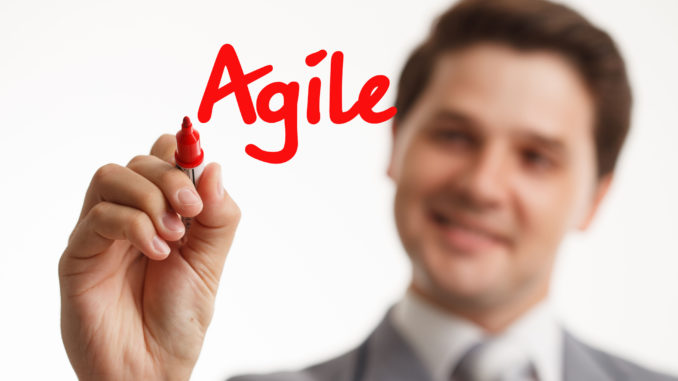
Sponsored
Scaled agile frameworks such as SAFe help organizations apply lean and agile principles to a large enterprise. SAFe describes Enterprise Architecture as a key element to “foster adaptive design, and engineering practices, and drive programs and teams to rally around a shared technical vision.”
In these new agile organizations, the role of enterprise architects is instrumental to provide strategic guidance, reference architectures and technology standards to the dev teams so that they work in a standardized manner. This can help avoid reworks due to potential misalignments with company standards and break down silos.
It is therefore essential to better understand the key elements of SAFe. More and more large organizations are adopting this framework, including the notions of architectural runway, intentional architecture and emergent design. Let’s see how the role of enterprise architects change to better interact with development teams, and how the EA practice might evolve in these new agile organizations.
1. SAFe and Business Architecture
Enterprise architects create value streams and business capabilities and share them with epic owners to help them create new business epics.
In business architecture, a value stream describes the steps needed to satisfy customers. It provides a product-centric approach to help organizations create products that deliver value to customers. This concept is also used in the Safe framework. The SAFe framework defines operational value streams that “contains the steps and the people who deliver end-user value.”
As for business capabilities, they are linked to each stage of the value streams to help organizations identify the required or missing capabilities. By assessing business capabilities based on their strategic alignment, complexity and performance, enterprise architects help prioritize development initiatives that focus on the capabilities that provide the most value to customers. Business capabilities can also be linked to user stories ensuring that agile developments are aligned with strategic objectives.
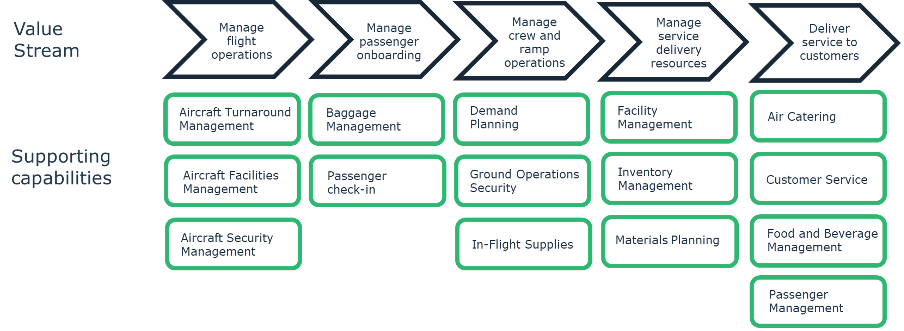
Example of a value stream with business capabilities
2. SAFe and the Architectural Runway
One of the key components of the SAFe framework is the architectural runway. In the SAFe framework, developments are broken down in program increments lasting from 8 to 12 weeks. To extend the architectural runway, enablers are used to support the activities needed to provide the future business functionalities. Enablers include infrastructure, compliance, and architecture developments. Enablers are built for the next program increment and ensure that business features developed in this next increment will land safely. Hence the term “runway” like a plane landing on a runway. To fuel the architectural runway, enterprise architects create enabler epics that contain information on application architecture, infrastructure, technology recommendations or regulatory requirements. They are put in a Kanban board to ensure that dev teams will implement them.
The architectural runway is consumed by teams as developments happen. Because business needs evolve and technologies become quickly outdated, the architectural runway evolves over time.
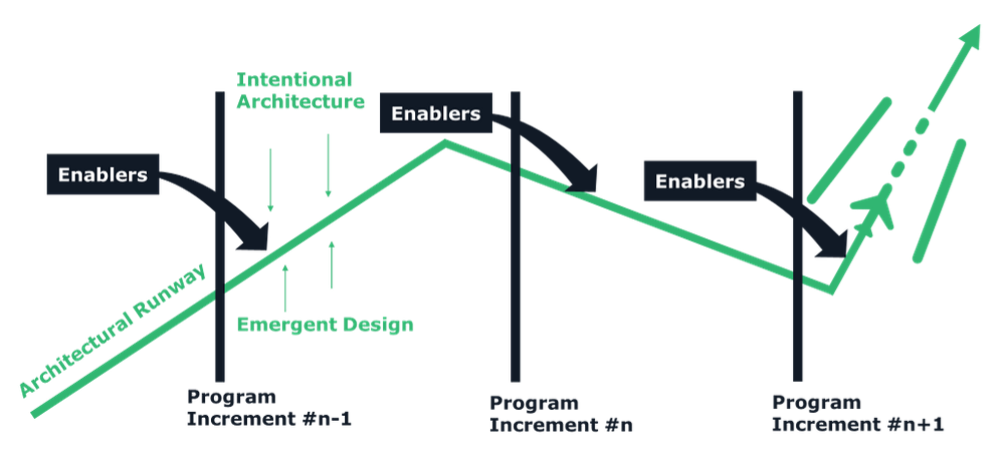
3. Intentional Architecture vs. Emergent Design
On the one hand, developments are moving fast, and agile teams are empowered to design the architecture they need based on the eleventh principle of the Agile Manifesto, “The best architectures, requirements, and designs emerge from self-organizing teams.” This is the emergent design, as called in the SAFe framework.
The emergent design corresponds to architecture and technical solutions made on the fly. It is guided by principles, tradeoffs, patterns, and often refactored.
On the other hand, enterprise architects design the intentional architecture. The intentional architecture is plan-based, high level, with the objective of aligning cross teams. It is a Foundational Enabler.
At some point, the intentional architecture should be reconciled with the emergent design to follow the changes that happened during the developments.
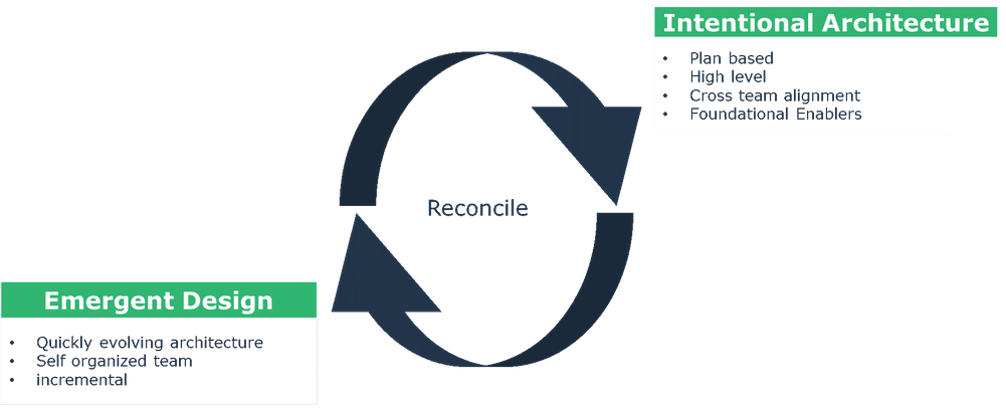
However, organizations encounter these shortcomings in most agile at scale environments including:
- Too much focus is given on emergent design to the expense of the strategic vision brought by enterprise architecture
- Too much emphasis is brought on programs rather than portfolios leading to a misalignment with strategic goals
That’s why balancing emergent design and intentional architecture is key. Emergent design is for small, tactical projects while intentional architecture brings the bigger picture forward.
4. The Evolving role of Enterprise Architects: Determine the best way to interact with dev teams
In agile environments, enterprise architects need to be a business partner and bring the strategic vision, while integrating regulatory constraints and policies, to all programs and projects. They build the intentional architecture that supports agile developments and work closely within dev teams to break down silos. Overall, they facilitate agile practice adoption and determine when to favor emergent design or intentional architecture.
If enterprise architects provide architectural guardrails to development teams, they need to determine the best way to interact with them. Depending on the level of interaction between enterprise architects and development teams, it can lead to an architecture too fragmented or an architecture disconnected from reality as described in the chart below.
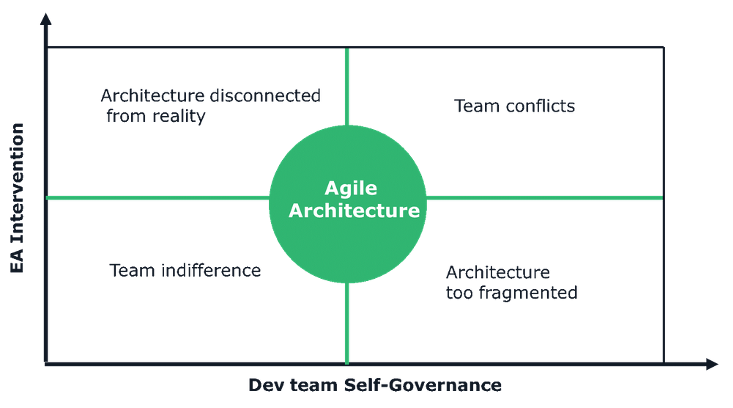
Thus, it is essential that enterprise architects determine the best way to interact with dev teams, and therefore properly balance intentional architecture and emergent design.
5. Evolution of the EA practice in Agile environments: give more power to localteams
In the “The five trademarks of agile organizations” article by McKinsey, the roots to transition from a traditional top-down organization to an agile organization can be found in the gap between the objectives of the management team and agile team.
Indeed, in traditional organizations, managers identify what needs to be done and tell employees what to do using a top-down approach. In agile organizations, the goal is to delight the customer. The work is done in self-organizing teams, with iterative work cycles and direct feedback from customers. The predominant values are transparency and continuous improvement.
In this new context, enterprise architecture will move from a top-down approach to a decentralized management approach and give more power to local teams. In this new model, local teams work on solution architecture managed at a local level. At the corporate level, the enterprise governance team provides strategic guidance for the whole organization.
The enterprise governance team works on business architecture, capturing business objectives and regulatory constraints, and assesses business opportunities, in particular with emerging technologies, and plans future business capabilities. They define technology standards and patterns leading to an increased security and economy of scale.
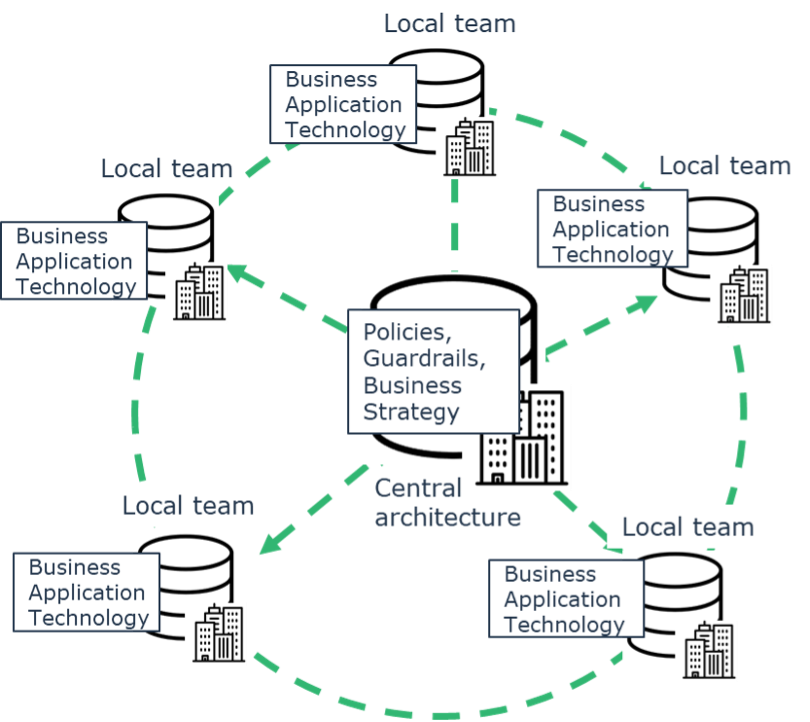
Enterprise architecture is a key component of the SAFe framework because it provides strategic guidance to the dev teams, including reference architecture models, technology standards, and regulatory constraints.
In these new agile organizations, enterprise architects might also need to find the right way to work with development teams and properly balance the emergent design vs. the intentional architecture.
As SAFe becomes an established framework within the organization, some of the governance may move outside of the enterprise architecture team to let local teams design their own architecture based on the defined strategic objectives.
Gabriel Gomane leads product marketing at MEGA International, focusing primarily on digital transformation and enterprise architecture. He has held various positions in product management and product marketing in technology companies in Europe and the United States. He holds an MBA from HEC Paris and a BSc in mechanical engineering from Grenoble INP. He can be reached at aggomane@mega.com



